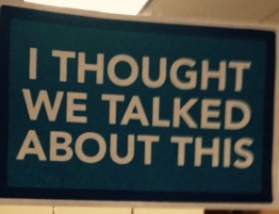
The Architecture of Managing People
March 28, 2015
The Three Types of Functional Management
March 30, 2015The Concept of Organizational Change
The only thing we know for certain is that change will be constant. I once thought a great company internal logo would be, “Change will be constant–so just do it.” As the world gets smaller, and the Baby Boomers get older, I can’t think of any business that won’t have to re-position its company image, its corporate culture, or the way it does business.
The ultimate challenge of the American business culture is to make change a basic cultural value. This means that an entire organization embraces change as the strength of the company, that the entire employee base, from senior manager to hourly employee, believes that change will be a positive and rewarding experience. The very idea that a culture could embrace change as a positive is almost too radical to be dealt with – American business works diligently to produce a standards and procedures environment, to ensure a consistent delivery of goods and services on a daily basis. The tendency of people who become successful in large companies is to formulate standards and rules to control and conform the work force. This ensures that change is very difficult, and that the employee has a clear but limited picture of their responsibility in the bureaucracy.
So the ultimate question is, if the goal has been to provide a controlled and procedure-oriented environment, how does the American bureaucracy do a 180 degree change and create one that fosters the level of risk required for the organization to process change? Especially the level of change inevitable in the coming years. This very question may be the ultimate issue that allows American businesses, the American government, local governments, and the American culture to survive in the future.
There are three ways change can take place. In each case the reason for change is separate from the process that accomplishes the change. But in all cases the manager’s abilities and skills determine the pace, receptiveness, attitudes and overall environment. Whether managed or not, change happens and over time it determines the new culture, the new rules, the new standards. Later on, things will change again and again. People will constantly try to change things for the better, while seeking to minimize change.
Changes happen in one of three ways. The first usually starts when organizations hire a manager from the outside because of their experience and technical expertise. These new managers usually come into the organization with ideas, attitudes and experiences that were part of their previous cultures. After adjusting to their new environment, they may try to implement their picture of how things should run in the new organization, depending on their self-esteem and/or insecurity. Many times these people leave their past organizations with manuals, forms and position papers in hand. They are confident that it has worked before and will therefore work again. This type of experience is most visible in athletics. When a team gets a new coach, the culture changes. The team’s playing style changes, a percentage of the players changes, and the measure of success is whether the new coach’s style wins or loses more games. These kinds of business changes don’t have as clear a vision of whether or not the change was successful. The style changes, the values change, and in most cases the players change.
The most important skills required to implement this type of change are communication and presentation skills. The ability to deliver a clear expectation is critical to helping people grasp the new values and define the new procedures and standards. Success of using outside talent to bring about change is best assured when the bureaucrat hired has direct, day-to-day contact with the area requiring change. This positioning requires the least amount of management skills because being close to the daily decisions ensures the outside talent is involved in important details not relying on the interpretation of a subordinate manager. The higher the level of entry into a bureaucracy, the greater the need for personal management skills, maturity, and respect to make the change work effectively.
The second kind of change is less defined and to my way of thinking, more common, with far greater implications for the organization’s overall culture. For some reason, whether from inside the company, an outside influence, or the fact that things just are not working, it is understood that things need to change. No one knows exactly what should happen, people just know things must change. The line that comes to mind is, “If we continue in our current direction we are liable to end up where we are headed.” In most instances a random periodical change process starts with a series of bureaucratic power plays. In each case the manager sees the opportunity to gain personal power and empire, and the win/lose mentality becomes pronounced. The resolution of this type of situation is not very predictable or orderly; things just start happening. Eventually, the organization’s power structure is realigned. Adjustment does happen, but the human price is very high, and, as the pace of change increases, so does the organization’s inability to deal with future change. People take sides, build walls, and become very insecure. This environment creates a great deal of intensity and stress, with people working many extra hours. Many projects are done twice: first to prepare for the boss’s turf battle, then again when the winner has been determined, and the real project has been defined. I believe many American companies are currently involved in this form of change. They are working very hard without knowing if they are headed in the right direction, and without much hope that their change process is delivering the best answers.
The last type of organizational change is in many ways the process I feel is required if America’s organizations and businesses are going to manage their way into the next century with a balance between the human factor and the level of productivity required to succeed. This change process is a culture of its own that management puts into place as an orderly and structured procedure that employees understand and in the end grow to trust. It accepts that the company must experience changes, and it values the fact that the people who do the work deserve to have some input into the conversation before rules and procedures are changed. I did not say that the people who do the job are the ones who have the best answers and therefore should solve the problem, though they may have many positive insights. In periods of rapid change they will lack a broad enough picture to understand the strategic implications of all that is taking place. Therefore it is very important that the change process accommodate their insights while holding the management team responsible for implementing the decision at the required pace.
As a training director I got the opportunity to facilitate many “quality circle” groups. The work groups with quality circles did find creative solutions to their problems and morale issues did get better, but the pace of decisions and implementation was too slow for the rate of change in the current American business environment. For this type of change process to be successful, it must be a combination of attitudes and procedures or techniques that allow a manager from middle to senior management to control the diverse issues confronting the current American business culture. I believe the process needs to take into account the diverse motivations of the people in the work place, allowing each a structured environment that is understandable while letting the manager have enough control to decide that this level of participation is not a waste of time and energy. This also involves convincing the organization that the process is more important than who wins, while allowing the historical bureaucrats to use their hard-won skills in a more harmonious and structured context.
The overall outcome of this management style will allow organizations to manage change, involve people and still do it at the pace required to survive in the future.





